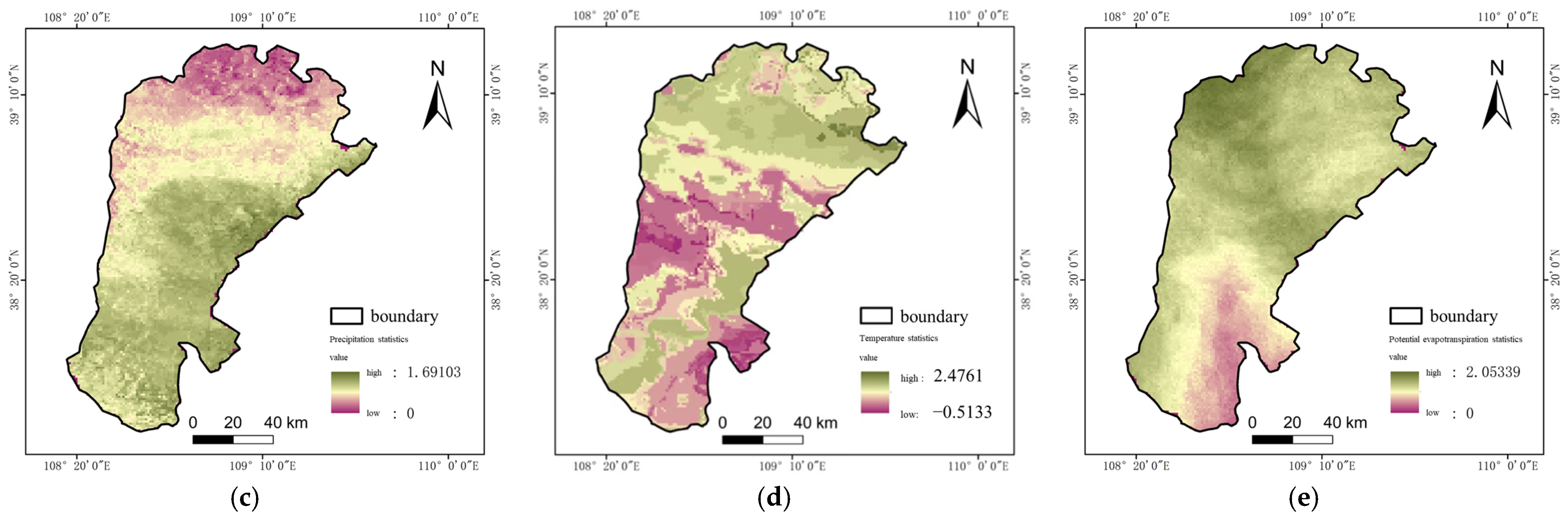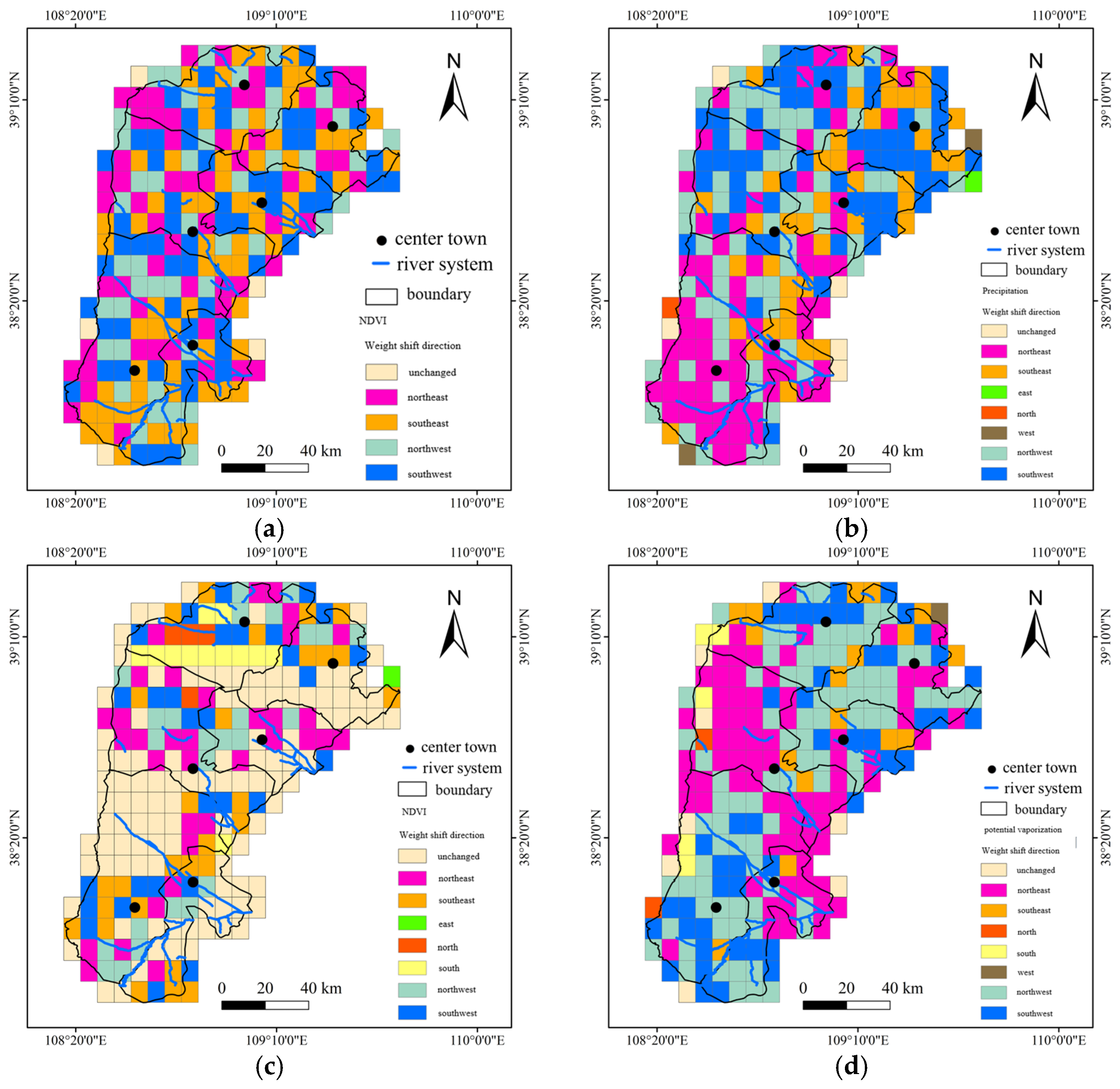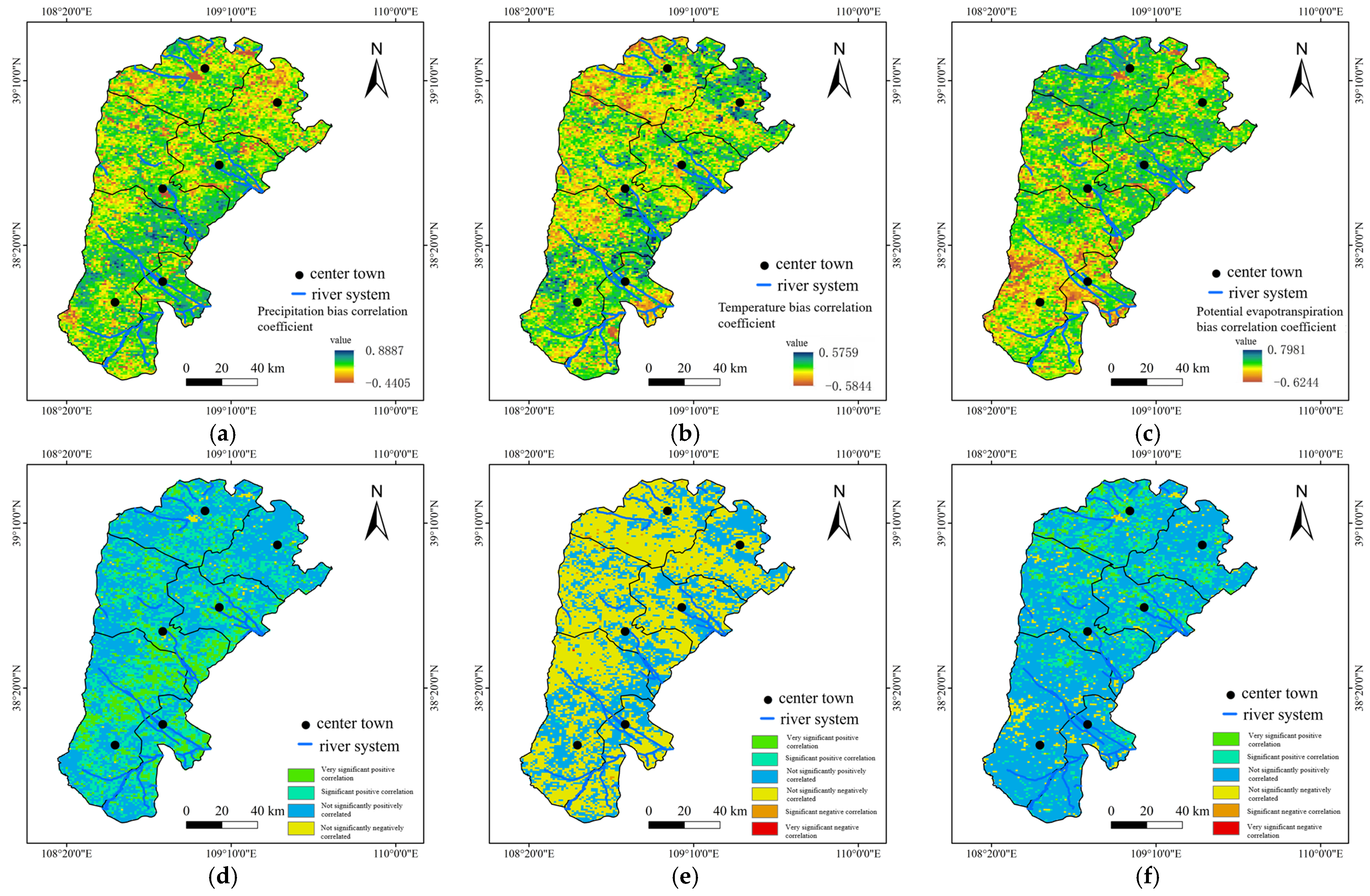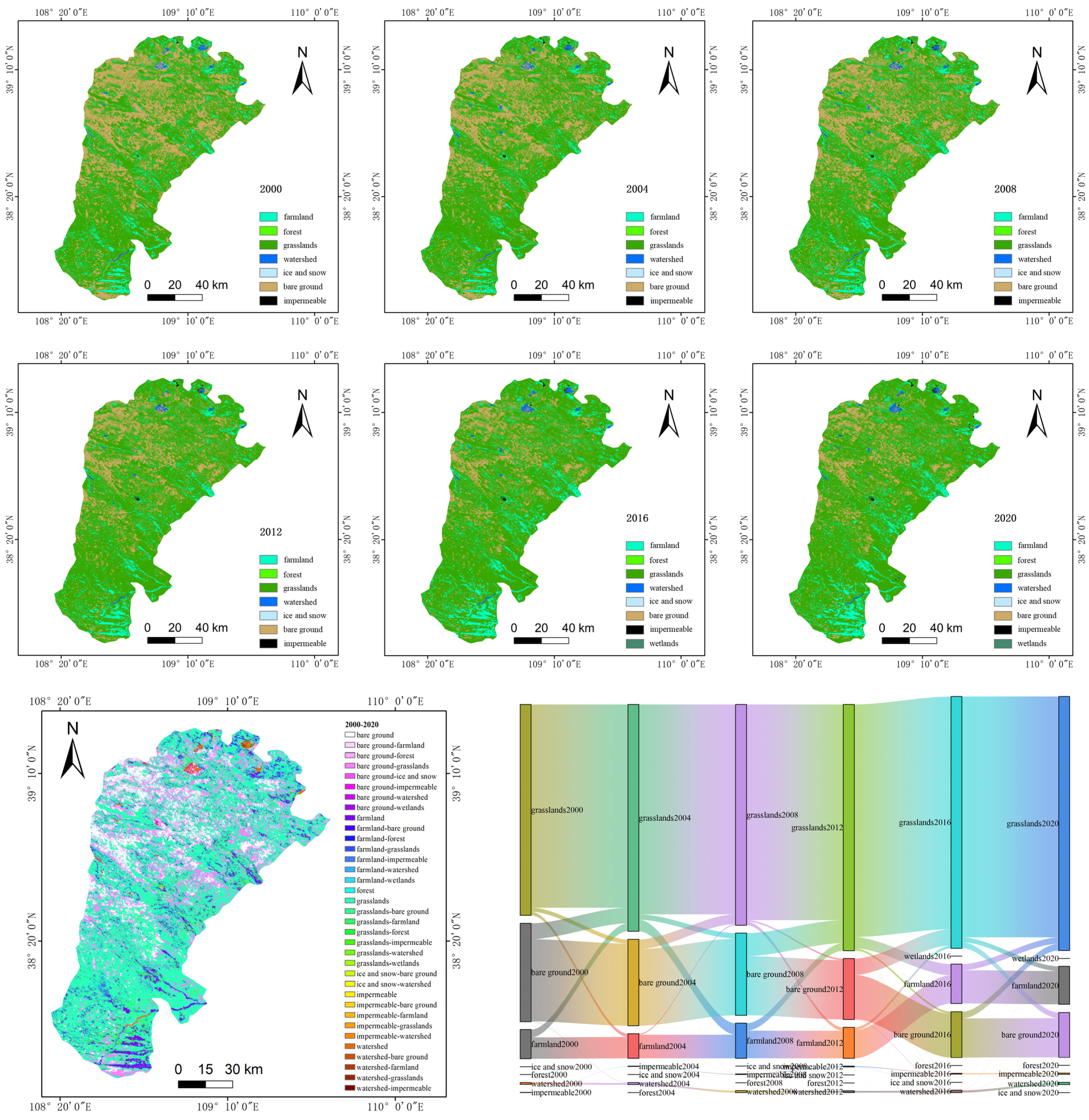Analysis of Spatial and Temporal Trends of Vegetation Cover Evolution and Its Driving Forces from 2000 to 2020—A Case Study of the WuShen Counties in the Maowusu Sandland
Abstract
1. Introduction
2. Materials and Methods
2.1. Overview of the Study Area
2.2. Data Sources and Pre-Processing
2.3. Research Methodology
2.3.1. Theil–Sen Trend Analysis with MK Significance Test
2.3.2. Fishnet Analysis and Center of Gravity Shift Model
2.3.3. Partial Correlation Analysis and t-Test
2.3.4. Multivariate Regression Residual Analysis
2.3.5. Driver Determination and Calculation
3. Results
3.1. Characterization of Temporal and Spatial Variations of NDVI and Climate Factors
3.2. Vegetation NDVI and Climate Factor Center of Gravity Changes and Mutual Response
3.3. Partial Correlation between NDVI and Climate Factors
3.4. Relative Contribution of Drivers to Changes in Vegetation NDVI
3.5. Effects of Land Use and Elevation Change on Vegetation-Driven Responses
4. Discussion
5. Conclusions
Author Contributions
Funding
Data Availability Statement
Conflicts of Interest
References
- Hang, X.; Li, Y.; Cao, Y.; Zhu, S.; Han, X.; Li, X.; Sun, L. Land Surface Eco-Environmental Situation Index (LSEESI) Derived from Remote Sensing. IEEE Trans. Geosci. Remote Sens. 2023, 61, 4408018. [Google Scholar] [CrossRef]
- van Oorschot, F.; van der Ent, R.J.; Hrachowitz, M.; Di Carlo, E.; Catalano, F.; Boussetta, S.; Balsamo, G.; Alessandri, A. Interannual land cover and vegetation variability based on remote sensing data in the HTESSEL land surface model: Implementation and effects on simulated water dynamics. Earth Syst. Dyn. 2023, 14, 1239–1259. [Google Scholar] [CrossRef]
- Lade, S.J.; Fetzer, I.; Cornell, S.E.; Crona, B. A prototype Earth system impact metric that accounts for cross-scale interactions. Environ. Res. Lett. 2021, 16, 115005. [Google Scholar] [CrossRef]
- Zhong, S.; Sun, Z.; Di, L. Characteristics of vegetation response to drought in the CONUS based on long-term remote sensing and meteorological data. Ecol. Indic. 2021, 127, 107767. [Google Scholar] [CrossRef]
- Bai, X.; Zhao, W. Impacts of climate change and anthropogenic stressors on runoff variations in major river basins in China since 1950. Sci. Total Environ. 2023, 898, 165349. [Google Scholar] [CrossRef] [PubMed]
- Pu, M.; Zhao, Y.; Ni, Z.; Huang, Z.; Peng, W.; Zhou, Y.; Liu, J.; Gong, Y. Spatial-temporal evolution and driving forces of NDVI in China’s Giant Panda National Park. Int. J. Environ. Res. Public Health 2022, 19, 6722. [Google Scholar] [CrossRef]
- Ma, B.X.; He, C.X.; Jing, J.L.; Wang, Y.F.; Liu, B.; He, H.C. Attribution of vegetation change in Southwest China from 1982 to 2019. Acta Geogr. Sin. 2019, 78, 714–728. [Google Scholar] [CrossRef]
- Jin, Y.-S.; Jin, K.; Wang, F.; Liu, C.-X.; Qin, P.; Zong, Q.-L.; Liu, P.-R.; Chen, M.-L. Effects of climate change and human activities on NDVI changes in the eastern coastal areas. Environ. Sci. 2023, 44, 3329–3342. [Google Scholar] [CrossRef]
- Gu, Y.; Pang, B.; Qiao, X.; Xu, D.; Li, W.; Yan, Y.; Dou, H.; Ao, W.; Wang, W.; Zou, C.; et al. Vegetation dynamics in response to climate change and human activities in the Hulun Lake basin from 1981 to 2019. Ecol. Indic. 2022, 136, 108700. [Google Scholar] [CrossRef]
- Zhang, X.; Jin, X. Vegetation dynamics and responses to climate change and anthropogenic activities in the Three-River Headwaters Region, China. Ecol. Indic. 2021, 131, 108223. [Google Scholar] [CrossRef]
- Qu, S.; Wang, L.; Lin, A.; Zhu, H.; Yuan, M. What drives the vegetation restoration in Yangtze River basin, China: Climate change or anthropogenic factors? Ecol. Indic. 2018, 90, 438–450. [Google Scholar] [CrossRef]
- Wang, Y.; Zhang, Z.; Chen, X. Quantifying influences of natural and anthropogenic factors on vegetation changes based on geodetector: A case study in the Poyang Lake Basin, China. Remote Sens. 2021, 13, 5081. [Google Scholar] [CrossRef]
- Ma, B.; Wang, S.; Mupenzi, C.; Li, H.; Ma, J.; Li, Z. Quantitative Contributions of Climate Change and Human Activities to Vegetation Changes in the Upper White Nile River. Remote Sens. 2021, 13, 3648. [Google Scholar] [CrossRef]
- Du, J.M.; Bao, G.; Tong, S.Q.; Huang, X.J.; Meili, W.; Bao, Y.H. Variations in vegetation cover and its relationship with climate change and human activities in Mongolia during the period 1982–2015. Acta Prataculturae Sin. 2021, 30, 1–13. [Google Scholar] [CrossRef]
- Xu, M.; Zhang, Z.; Wang, Y.; Liu, B. Quantifying the contributions of climatic and human factors to vegetation net primary productivity dynamics in East Africa. Front. For. Glob. Chang. 2024, 6, 1332631. [Google Scholar] [CrossRef]
- Zeng, Y.; Jia, L.; Menenti, M.; Jiang, M.; Zheng, C.; Bennour, A.; Lv, Y. Regional divergent evolution of vegetation greenness and climatic drivers in the Sahel-Sudan-Guinea region: Nonlinearity and explainable machine learning. Front. For. Glob. Chang. 2024, 7, 1416373. [Google Scholar] [CrossRef]
- Xiao, H.; Liu, J.; He, G.; Zhang, X.; Wang, H.; Long, T.; Zhang, Z.; Wang, W.; Yin, R.; Guo, Y.; et al. Data-driven forest cover change and its driving factors analysis in Africa. Front. Environ. Sci. 2022, 9, 780069. [Google Scholar] [CrossRef]
- Liu, Z.; Wimberly, M.C.; Dwomoh, F.K. Vegetation dynamics in the upper Guinean forest region of West Africa from 2001 to 2015. Remote Sens. 2016, 9, 5. [Google Scholar] [CrossRef]
- Cao, Y.P.; Pang, Y.J.; Jia, X.H. Vegetation growth in Mu Us Sandy Land from 2001 to 2016. Bull. Soil Water Conserv. 2019, 39, 29–37. [Google Scholar] [CrossRef]
- Gao, W.; Zheng, C.; Liu, X.; Lu, Y.; Chen, Y.; Wei, Y.; Ma, Y. NDVI-based vegetation dynamics and their responses to climate change and human activities from 1982 to 2020: A case study in the Mu Us Sandy Land, China. Ecol. Indic. 2022, 137, 108745. [Google Scholar] [CrossRef]
- Ye, Q.; Liu, H.; Lin, Y.; Han, R. Study of Maowusu Sandy Land Vegetation Coverage Change Based on MODIS NDVI. The International Archives of the Photogrammetry. Remote Sens. Spat. Inf. Sci. 2018, 42, 2127–2133. [Google Scholar] [CrossRef]
- Wang, Z.; Zhang, T.; Pei, C.; Zhao, X.; Li, Y.; Hu, S.; Bu, C.; Zhang, Q. Multisource remote sensing monitoring and analysis of the driving forces of vegetation restoration in the Mu Us sandy land. Land 2022, 11, 1553. [Google Scholar] [CrossRef]
- Didan, K. MODIS/Terra Vegetation Indices Monthly L3 Global 1 km SIN Grid V006. In NASA EOSDIS Land Processes DAAC; NASA: Washington, DC, USA, 2015. [Google Scholar] [CrossRef]
- He, Q.; Wang, M.; Liu, K.; Li, K.W.; Jiang, Z.Y. GPRChinaTemp1km: 1 km monthly mean air temperature for China from January 1951 to December 2020. Earth Syst. Sci. Data 2021, 14, 3273–3292. [Google Scholar] [CrossRef]
- Qu, L.; Zhu, Q.; Zhu, C.; Zhang, J. Monthly precipitation data set with 1 km resolution in China from 1960 to 2020. Sci. Data Bank. 2022, 8. [Google Scholar] [CrossRef]
- Peng, S.Z. 1 km Monthly Potential Evapotranspiration Data Set in China (1990–2021); National Science Data Center of the Qinghai-Tibet Plateau: Beijing, China, 2022. [Google Scholar] [CrossRef]
- Peng, S.Z.; Ding, Y.X.; Wen, Z.M.; Chen, Y.M.; Cao, Y.; Ren, J.Y. Spatiotemporal change and trend analysis of potential evapotranspiration over the Loess Plateau of China during 2011–2100. Agric. For. Meteorol. 2017, 233, 183–194. [Google Scholar] [CrossRef]
- Peng, S.Z.; Ding, Y.X.; Liu, W.Z.; Li, Z. 1 km monthly temperature and precipitation dataset for China from 1901 to 2017. Earth Syst. Sci. Data 2019, 11, 1931–1946. [Google Scholar] [CrossRef]
- Wu, S.; Yan, X.; Yang, B.; Yu, T.; Zhang, J. Spatial and temporal variation analysis of China’s potential evaporation. J. Surv. Mapp. 2022, 4, 1460–1464. [Google Scholar]
- Yang, J.; Huang, X. The 30 m annual land cover dataset and its dynamics in China from 1990 to 2019. Earth Syst. Sci. Data 2021, 13, 3907–3925. [Google Scholar] [CrossRef]
- Yang, J.; Huang, X. The 30 m Annual Land Cover Datasets and Its Dynamics in China from 1990 to 2021 (1.0.0) [Data Set]; Zenodo: Geneva, Switzerland, 2022. [Google Scholar] [CrossRef]
- Vrsalović, A.; Andrić, I.; Bonacci, O.; Kovčić, O. Climate variability and trends in Imotski, Croatia: An analysis of temperature and precipitation. Atmosphere 2023, 14, 861. [Google Scholar] [CrossRef]
- Zeleňáková, M.; Vido, J.; Portela, M.M.; Purcz, P.; Blištán, P.; Hlavatá, H.; Hluštík, P. Precipitation trends over Slovakia in the period 1981–2013. Water 2017, 9, 922. [Google Scholar] [CrossRef]
- Wang, F.; Shao, W.; Yu, H.; Kan, G.; He, X.; Zhang, D.; Ren, M.; Wang, G. Re-evaluation of the power of the Mann-Kendall test for detecting monotonic trends in hydrometeorological time series. Front. Earth Sci. 2020, 8, 14. [Google Scholar] [CrossRef]
- Yang, L.; Fei, S.; Jia, H.; Qi, J.; Wang, L.; Hu, X. Study on the relationship between the spatial distribution of shared bicycle travel demand and urban built environment. Sustainability 2023, 15, 13576. [Google Scholar] [CrossRef]
- Hu, L.; Jiang, C.Y.; Li, Z.B.; Zhang, X.; Li, P.; Wang, Q.; Zhang, W.J. Evolution path analysis of economic gravity center and air pollutants gravity center in Shaanxi province. Adv. Mater. Res. 2012, 361, 1359–1363. [Google Scholar] [CrossRef]
- Liu, Y.; Wang, P. Partial Correlation Analysis Based Identification of Distribution Network Topology. CSEE J. Power Energy Syst. 2023, 9, 1493–1504. [Google Scholar] [CrossRef]
- Keithley, R.B.; Wightman, R.M.; Heien, M.L. Multivariate concentration determineation using principal component regression with residual analysis. TrAC Trends Anal. Chem. 2009, 28, 1127–1136. [Google Scholar] [CrossRef]
- Yang, Y. Prediction and analysis of aero-material consumption based on multivariate linear regression model. In Proceedings of the 2018 IEEE 3rd International Conference on Cloud Computing and Big Data Analysis (ICCCBDA), Chengdu, China, 20–22 April 2018; IEEE: Piscataway, NJ, USA, 2018; pp. 628–632. [Google Scholar] [CrossRef]
- Torres-Signes, A.; Frías, M.P.; Ruiz-Medina, M.D. COVID-19 mortality analysis from soft-data multivariate curve regression and machine learning. Stoch. Environ. Res. Risk Assess. 2021, 35, 2659–2678. [Google Scholar] [CrossRef] [PubMed]
- Stow, D.; Daeschner, S.; Hope, A.; Douglas, D.; Petersen, A.; Myneni, R.; Zhou, L.; Oechel, W. Variability of the seasonally integrated normalized difference vegetation index across the north slope of Alaska in the 1990s. Int. J. Remote Sens. 2003, 24, 1111–1117. [Google Scholar] [CrossRef]
- Cook, R.D.; Weisberg, S. Partial one-dimensional regression models. Am. Stat. 2004, 58, 110–116. [Google Scholar] [CrossRef]
- Wang, Z.; Wu, Y.; Li, D.; Fu, T. The southern boundary of the Mu Us Sand Sea and its controlling factors. Geomorphology 2022, 396, 108010. [Google Scholar] [CrossRef]
- Shammi, S.A.; Meng, Q. Modeling crop yield using NDVI-derived VGM metrics across different climatic regions in the USA. Int. J. Biometeorol. 2023, 67, 1051–1062. [Google Scholar] [CrossRef]
- Sun, Z.; Mao, Z.; Yang, L.; Liu, Z.; Han, J.; Wanag, H.; He, W. Impacts of climate change and afforestation on vegetation dynamic in the Mu Us Desert, China. Ecol. Indic. 2021, 129, 108020. [Google Scholar] [CrossRef]
- Li, Y.; Cao, Z.; Long, H.; Liu, Y.; Li, W. Dynamic analysis of ecological environment combined with land cover and NDVI changes and implications for sustainable urban–rural development: The case of Mu Us Sandy Land, China. J. Clean. Prod. 2017, 142, 697–715. [Google Scholar] [CrossRef]
- Lin, M.; Hou, L.; Qi, Z.; Wan, L. Impacts of climate change and human activities on vegetation NDVI in China’s Mu Us Sandy Land during 2000–2019. Ecol. Indic. 2022, 142, 109164. [Google Scholar] [CrossRef]












| Slope (NDVIobs) a | Driving Force | Criteria for Classifying Drivers | Contribution of Drivers (%) | ||
|---|---|---|---|---|---|
| Slope (NDVICC) b | Slope (NDVIHA) c | Climate Change | Human Activity | ||
| >0 | CC and HA | >0 | >0 | slope (NDVICC) | slope (NDVIHA) |
| slope (NDVIobs) | slope (NDVIobs) | ||||
| CC | >0 | <0 | 100 | 0 | |
| HA | <0 | >0 | 0 | 100 | |
| <0 | CC and HA | <0 | <0 | slope (NDVICC) | slope (NDVIHA) |
| slope (NDVIobs) | slope (NDVIobs) | ||||
| CC | <0 | >0 | 100 | 0 | |
| HA | >0 | <0 | 0 | 100 | |
| The Direction of the Transfer | NDVI and Precipitation | NDVI and Temperature | NDVI and PET | Precipitation and Temperature | Precipitation and PET | Temperature and PET |
|---|---|---|---|---|---|---|
| Directional consistency | 24.07 | 15.77 | 23.65 | 17.43 | 29.46 | 17.84 |
| Opposite direction | 25.31 | 15.77 | 26.56 | 12.86 | 23.65 | 12.03 |
| Other | 50.62 | 68.46 | 49.79 | 69.71 | 46.89 | 70.12 |
| Relative Contribution (%) | Area Proportion (%) | ||||||
|---|---|---|---|---|---|---|---|
| <−20 | −20~0 | 0~20 | 20~40 | 40~60 | 60~80 | ≥80 | |
| Climate change | 0.31 | 0.72 | 45.75 | 31.71 | 10.72 | 4.34 | 6.45 |
| Human activity | 6.27 | 0.04 | 6.54 | 4.34 | 10.72 | 31.71 | 40.38 |
Disclaimer/Publisher’s Note: The statements, opinions and data contained in all publications are solely those of the individual author(s) and contributor(s) and not of MDPI and/or the editor(s). MDPI and/or the editor(s) disclaim responsibility for any injury to people or property resulting from any ideas, methods, instructions or products referred to in the content. |
© 2024 by the authors. Licensee MDPI, Basel, Switzerland. This article is an open access article distributed under the terms and conditions of the Creative Commons Attribution (CC BY) license (https://creativecommons.org/licenses/by/4.0/).
Share and Cite
Zhao, Z.; Liu, X.; Liu, T.; Wu, Y.; Wang, W.; Tian, Y.; Fu, L. Analysis of Spatial and Temporal Trends of Vegetation Cover Evolution and Its Driving Forces from 2000 to 2020—A Case Study of the WuShen Counties in the Maowusu Sandland. Forests 2024, 15, 1762. https://doi.org/10.3390/f15101762
Zhao Z, Liu X, Liu T, Wu Y, Wang W, Tian Y, Fu L. Analysis of Spatial and Temporal Trends of Vegetation Cover Evolution and Its Driving Forces from 2000 to 2020—A Case Study of the WuShen Counties in the Maowusu Sandland. Forests. 2024; 15(10):1762. https://doi.org/10.3390/f15101762
Chicago/Turabian StyleZhao, Zeyu, Xiaomin Liu, Tingxi Liu, Yingjie Wu, Wenjuan Wang, Yun Tian, and Laichen Fu. 2024. "Analysis of Spatial and Temporal Trends of Vegetation Cover Evolution and Its Driving Forces from 2000 to 2020—A Case Study of the WuShen Counties in the Maowusu Sandland" Forests 15, no. 10: 1762. https://doi.org/10.3390/f15101762
APA StyleZhao, Z., Liu, X., Liu, T., Wu, Y., Wang, W., Tian, Y., & Fu, L. (2024). Analysis of Spatial and Temporal Trends of Vegetation Cover Evolution and Its Driving Forces from 2000 to 2020—A Case Study of the WuShen Counties in the Maowusu Sandland. Forests, 15(10), 1762. https://doi.org/10.3390/f15101762





